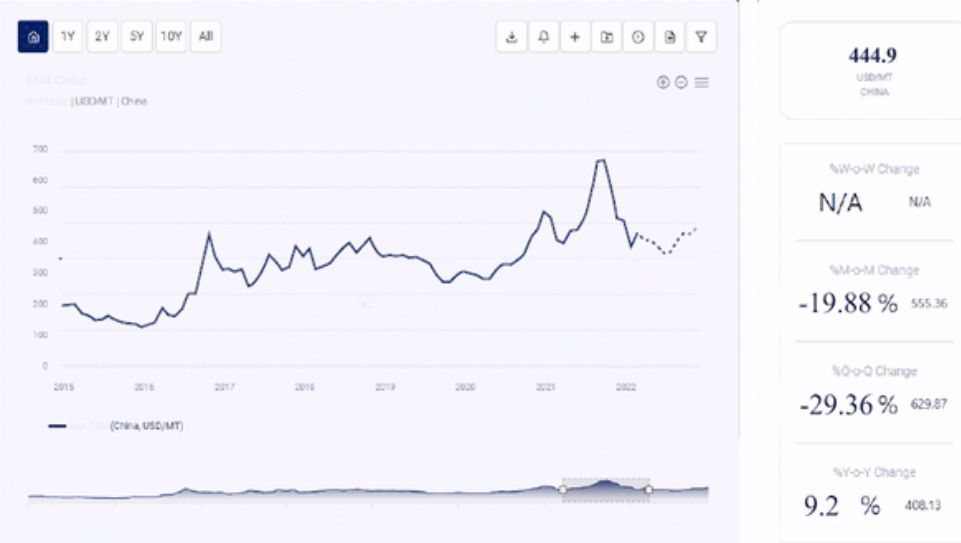Cold Rolled Steel Sheet Price chart, including India Cold Rolled Steel Sheet price, USA Cold Rolled Steel Sheet price, pricing database, and analysis can prove valuable for procurement managers, directors, and decision-makers to build up their strongly backed-up strategic insights to attain progress and profitability in the business.
Cold Rolled Steel Sheet (CRSS) is a result of material obtained from hot-rolled descaled steel, which is cold reduced to the required sheet thickness, which is then followed by annealing to recrystallize the grain structure. The product’s composition varies, depending upon the grade and type of steel used in manufacturing the unit. It refers to rolling and surfacing flat-rolled sheets and coil products.
In general, High Strength Low Alloy Steel, which is a class 1 Cold Rolled Steel, comprises elements, namely, carbon, manganese, phosphorous, sulfur, aluminium, copper, nickel, titanium, columbium, molybdenum, and vanadium in different proportions. It shows corrosion resistance and has a very smooth surface finish.
Japan, India, and China are the key exporting countries for Cold Rolled Steel Sheets. On the other hand, the primary importing countries for the same are India, Indonesia, and Vietnam.
Key Details About the Cold Rolled Steel Sheet Price Trend:
Procurement Resource does an in-depth analysis of the price trend to bring forth the monthly, quarterly, half-yearly, and yearly information on the Cold Rolled Steel Sheet price in its latest pricing dashboard. The detailed assessment deeply explores the facts about the product, price change over the weeks, months, and years, key players, industrial uses, and drivers propelling the market and price trends.
Each price record is linked to an easy-to-use graphing device dated back to 2014, which offers a series of functionalities; customization of price currencies and units and downloading of price information as excel files that can be used offline.
Industrial Uses Impacting Cold Rolled Steel Sheet Price Trend:
Cold Rolled Steel Sheets have a wide range of industrial uses, from home appliances to industrial machinery. Products like water heaters, metal containers, frying pans, fan blades, computer cabinets, washing machines, microwave ovens, fans, washers, refrigerators, computer hardware, pressure vessels, and automobiles use Cold Rolled Sheets for manufacturing purposes.
Additionally, it is used in construction sectors on a large scale for making structures like columns, beams, and sections that use CRSS to manufacture steel sheds, garages, industrial buildings, and much more. It can be cut, punched, bent, drilled, and easily formed into desired shapes and structures, which makes it a workable industrial product. It has a glossy and clean surface, which makes it a popular choice opted by the mechanical and household industries.
Industrial uses impacting the cold rolled steel sheet price trend encompass a variety of sectors where cold rolled steel sheets serve as a fundamental material or component. These industrial applications significantly influence the demand, supply, and pricing dynamics of cold rolled steel sheets in the market. Some key industrial uses impacting the cold rolled steel sheet price trend include:
Automotive Industry: Cold rolled steel sheets are extensively used in the automotive sector for manufacturing vehicle body panels, chassis components, and structural parts. Fluctuations in automotive production volumes, consumer demand for fuel-efficient vehicles, and regulatory requirements for lightweight materials influence the demand for cold rolled steel sheets.
Construction and Infrastructure: Cold rolled steel sheets find applications in the construction of buildings, bridges, infrastructure projects, and residential housing. The construction industry's demand for high-quality steel products, including cold rolled steel sheets, depends on factors such as urbanization trends, government investments in infrastructure, and building regulations.
Appliances and Home Goods: Cold rolled steel sheets are utilized in the production of household appliances such as refrigerators, washing machines, dishwashers, and ovens. Demand for cold rolled steel sheets in the appliances sector is driven by replacement cycles, consumer preferences for durable and aesthetically pleasing products, and technological advancements in appliance design.
Manufacturing and Machinery: Cold rolled steel sheets are essential for manufacturing machinery, equipment, and industrial components across various sectors, including aerospace, machinery, and metal fabrication. Demand for cold rolled steel sheets in the manufacturing sector is influenced by industrial activity levels, capital investment trends, and technological advancements in manufacturing processes.
Packaging and Containers: Cold rolled steel sheets are used in the production of packaging materials, containers, and metal enclosures for consumer goods, food products, and industrial applications. Demand for cold rolled steel sheets in the packaging sector depends on factors such as consumer spending patterns, e-commerce growth, and sustainability initiatives.
Energy and Utilities: Cold rolled steel sheets are employed in the energy sector for manufacturing equipment, pipelines, and storage tanks used in oil and gas exploration, power generation, and renewable energy projects. Demand for cold rolled steel sheets in the energy industry is influenced by energy demand-supply dynamics, investment trends, and regulatory requirements.
Electronics and Electrical Components: Cold rolled steel sheets find applications in the electronics industry for manufacturing electrical enclosures, consumer electronics, and electronic components. Demand for cold rolled steel sheets in the electronics sector depends on technological advancements, product innovation, and consumer electronics trends.
Furniture and Fixtures: Cold rolled steel sheets are utilized in the production of furniture, fixtures, and interior design elements for residential, commercial, and institutional settings. Demand for cold rolled steel sheets in the furniture sector is driven by design trends, construction projects, and consumer preferences for durable and stylish furnishings.
Understanding these industrial uses impacting the cold rolled steel sheet price trend is crucial for stakeholders, including steel manufacturers, suppliers, distributors, and consumers, to anticipate demand patterns, assess market opportunities, and formulate strategic decisions in the dynamic cold rolled steel sheet market.
Key Players:
- JSW Steel Coated Products Limited
- Jindal Stainless Steelway Limited
- Tata Iron Syndicate
- Gaurang Product Private Limited
- Shri Laxmi Steel Suppliers








